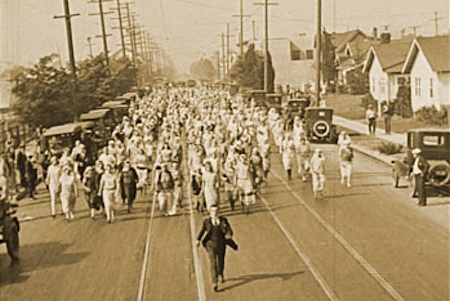The latest edition of the Sight & Sound Critics’ Poll of the greatest films of all time, held only once every decade, is full of delights and disappointments, with an epochal change at the top: Citizen Kane at long last unseated from the throne by Vertigo. The rise of other films through the rankings, led by 1929 groundbreaker Man with a Movie Camera’s first entry into the top ten, are well worth celebrating. (I’m also heartened to see the ascendance of Ozu’s Late Spring, Akerman’s Jeanne Dielman, Rossellini’s Voyage to Italy, Dreyer’s Ordet and Gertrud, Jacques Tati’s Playtime, and Godard’s Histoire(s) du Cinema, the last being possibly the ultimate “video essay”). Misfortune met other titles as they spilled down the list: Singin’ in the Rain, Pather Panchali, M, Barry Lyndon, The Magnificent Ambersons, The Third Man, Intolerance.
One of the saddest declines befell The General. Buster Keaton’s 1926 masterpiece once ranked among the top ten in the 1972 and 1982 editions of the poll; in 2002 it still held firm at #15. This year it suffered its lowest ranking in decades, at #34. Keaton rival Charlie Chaplin fared no better, his sublime City Lights barely making the top 50. One might ascribe their fates to a lessening interest in silent cinema, but to the contrary, on the whole pre-talkie movies did as well as they ever had (with three occupying the top 10). Silent films certainly did much better than the other genre befitting Keaton and Chaplin, the comedy. Of the top 50 films in the poll, only seven are comedies (and only 9 in the top 100!), so it would seem the 846 participating critics and programmers lack a sense of humor. (For what it’s worth, my list included one comedy, the sublime and underseen 1946 gem Under the Bridges).
One also has to wonder if Keaton’s decline in the poll reflects a generational shift among the voting pool. Back in the 1950s and 1960s, Keaton, long neglected by Hollywood as a washed-up silent clown, became something of a cause célèbre among the first auteurist critics in the US and abroad. (A critics’ poll at the 1955 Brussels World Fair hoisted Sherlock Jr. as the greatest film of all time). Keaton’s kinetic vision and death-defying craft was steadily championed through retrospective screenings and film classes, and by 1972, The General finally cracked the Sight & Sound top ten.
Ranking among Keaton’s most devoted champions during (and well beyond) that period was Andrew Sarris, the legendary critic who passed away just two months ago. Sarris pioneered the notion that Hollywood directors could be seen as artists, and Keaton held a central place in his personal pantheon. I can’t help but think that Sarris’s passing and Keaton’s fall in the S&S poll have a symbolic connection, in the sense that a generation of critics like Sarris is gradually leaving our midst, giving way to other critics, values and favorite films.
Buster Keaton could be hilarious on occasion, but most of his work is not geared to a laugh meter. The Frozen North strikes me as his funniest film, with Cops, The High Sign, and The Goat not too far behind. Significantly, these are all short films. Even in these works, the virtuosity unveiled often transforms the wild laugh into an appreciative chuckle. All in all, Keaton is far from being the funniest comedian ever, yet he could generate the belly laugh when he so desired.
Keaton’s comedy, for the most part, does not deflate pomposity or overthrow the powers that be, at least not by conscious design. Cops became an underground classic in the late sixties because of the sheer number of “pigs” who were zapped and lampooned in the course of Buster’s madcap adventures. But Keaton is no anarchic angel. Much of the havoc he wreaks is caused by his lofty indifference to convention. At his best, he is consumed by an obsessive logic that impels him into a physically and visually harmonious relationship with the world around him. His forte is construction rather than demolition. Keaton walking into the movie screen in Sherlock Jr., Keaton dangling confidently from the mast in The Navigator, swinging from the falls in Our Hospitality, fleeing from the hordes of would-be brides in a continuous shot in Seven Chances, and above all, riding the whirlwind itself, to Oedipal reversal in Steamboat Bill Jr. by saving his father from drowning. If one assembles all these haunting images, and many more, the composite effect in one’s mind is a spectacle at which one must gasp rather than guffaw.
If one thinks of a comedy/ha-ha as the most important part of screen comedy, one must conclude that the funniest films are almost invariably destructive and subversive and, more often than we like to admit, ratty and mean-spirited. The eternal appeal of the ethnic joke attests to the criterion of cruelty in these matters. So much “humor” is based on feelings of contempt, superiority, and comparative sophistication and normality.
When Buster Keaton was three years old, a Kansas cyclone lifted him out of a second story window and deposited him unharmed in the middle of an unpaved main street some four blocks away. In Steamboat Bill Jr. Keaton seems to draw on intuitive insights into the cyclonic forces of nature, and the state of grace and adaptability necessary to survive them. In the end, he triumphs over adversity by a majestic submission to the forces of motion, the very forces that constitute the logic and magic of all movies.
Andrew Sarris




